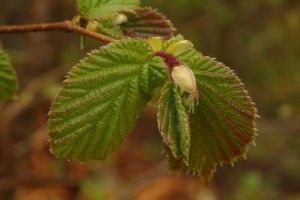
Spring has been really late in northern Scotland this year and by the end of April most of the trees were still leafless. In most years, the birches, rowans and other trees generally get their new leaves in the second half of April, but the cold spring we’ve had in 2015 has delayed everything. It was only in the early part of May therefore that the new leaves finally started opening on the trees, and when I went to Glen Affric on the 10th of May, the forest was radiant with the vibrant, bright green flush of the fresh leaves.
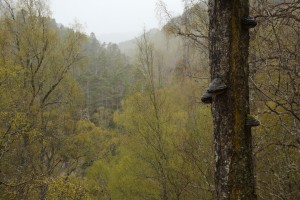
Because of our northerly latitude (approximately 57 degrees north at Glen Affric), the trees only have leaves for half of the year. Gaining them normally in late April, most species lose their leaves in late October, giving them just 6 months in which to utilise the sun’s energy through photosynthesis to manufacture the organic compounds needed for growth. A delayed spring like this one, where the emergence of the new leaves is about 3 weeks late, will therefore reduce the period in which the trees are actively growing.
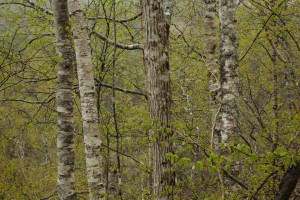
I doubt this delay in leaf burst will have any significant effect on the trees, and the emergence does vary from year to anyway, even if this one is later than most. It does make me wonder though about the potential effects of global warming, as one school of thought predicts a shift in the Gulf Stream, which brings relatively warm ocean water (and resultant mild temperatures) to the west coast of Scotland. Such a shift could trigger considerably colder temperatures in the country, potentially pushing spring later in the year on a more permanent basis.
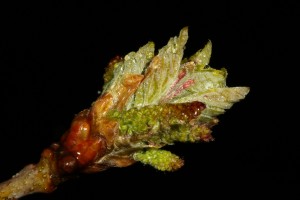
Rather than dwelling on changes that might occur in the years ahead, however, I immersed myself in the beauty and intricate delicacy of this profound moment in the annual cycle of the life of trees – the emergence of their new leaves. While trees such as birch (Betula spp.) already had their leaves fully open, oak (Quercus petraea) is one of the later species to gain its leaves, and when I stopped at one of my favourite oaks in Affric, right beside the road above Badger Falls, I saw that its leaves were just bursting.
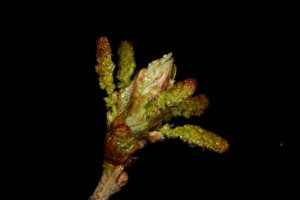
This oak is growing on a steep slope beside a burn below the road, and its branches are perfectly positioned at eye level from the parapet of a small bridge over the burn. I often stop to look at this tree, to see if there is anything of interest on it, and today was no exception. I noticed immediately that almost all of its buds had not only leaves but also catkins emerging from them – I’d never seen so many catkins on it before.
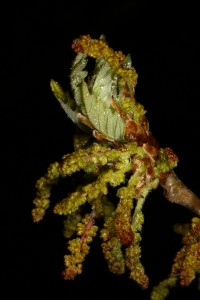
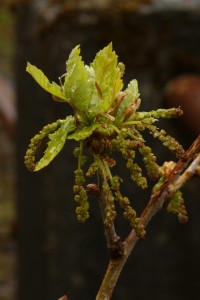
As I looked at the branches on the tree, I found examples of the catkins and leaves at different stages of unfolding. I imagined that if I stayed in one place for long enough and watched a single bud open, it would almost be like watching a ballet dancer moving gracefully in slow motion …
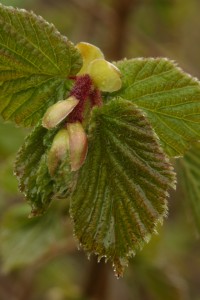
I’ll check this tree again in the months ahead to see if all the catkins result in a good crop of acorns – I’ve hardly ever seen acorns on it in the past. Just next to the oak is a hazel (Corylus avellana), so I spent some time photographing some of its leaves as well.
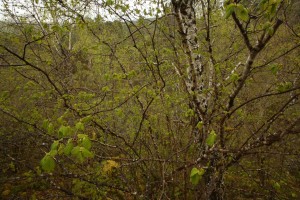
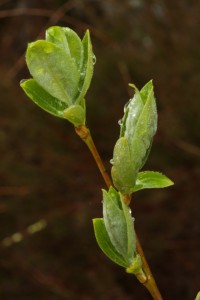
A little further along the road, a goat willow (Salix caprea) drew my attention. Its leaves emerge with a slightly different shade of green to birch or hazel, and as a result the tree stood out from the others around it.
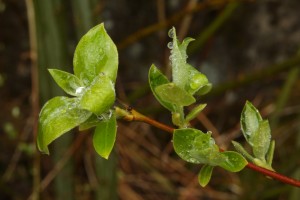
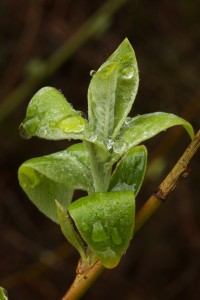
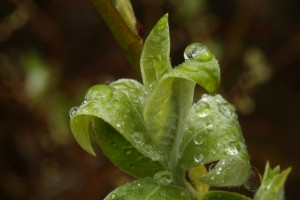
The leaves of goat willow are slightly pubescent or hairy and this facilitates water droplets staying on them for longer than on some smoother leaves of other trees. From the right angle of view these water droplets are like little crystals, capturing the light and adding a brilliant radiance to the leaves ….
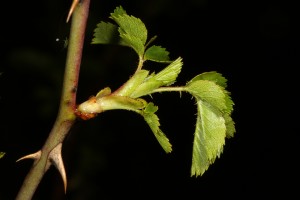
While I was looking at the goat willow, I spotted a dog rose (Rosa canina) nearby, also with its leaves just opening out, so I went over to have a closer look at it. Dog rose is not a tree of course, but is a woody shrub and is common in some parts of the Caledonian Forest, especially where the soils are richer and better drained, such as here, on the south-facing slope between Badger Falls and Dog Falls.
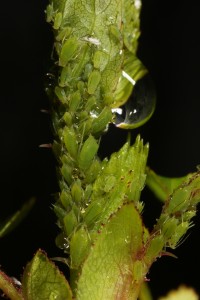
Last year I’d found some aphids on a dog rose further west in Glen Affric, but I hadn’t been able to get them identified. I was interested to see if there were any on this plant, and sure enough there were.
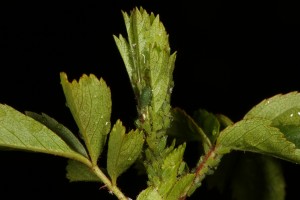
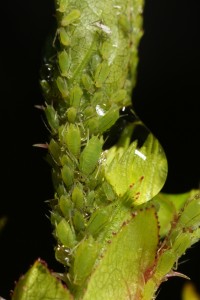
These aphids looked slightly different to those I’d seen before, and when I sent the photos to Ed Baker, who helps me with identifications, he said they could possibly be Metopolophium dirhodum.
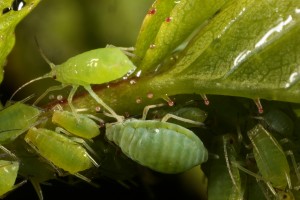
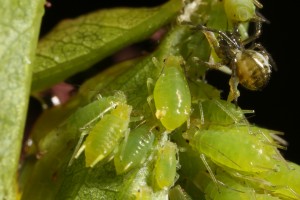
I’m not familiar with that species myself, but it is relatively common and alternates between two different plant groups as hosts – roses (Rosa spp.) as its primary host in spring, and cereals and grasses, including wheat and barley, as the secondary host in summer. Neither of those are in Glen Affric of course, so if these aphids are indeed that species, they must be alternating with a wild grass in the glen. I’ve sent specimens of the aphids off to Ed and I’ll wait to hear his confirmation of their identity. Comment added on 13 July 2018: The striped aphid in the photo above on the left has been identified as being a fundatrix (ie founding female of a population in the spring) of the species, Longicaudus trirhodus, by Bob Dransfield, another aphid specialist who helps me with identifications.
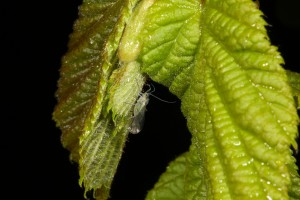
Having got my eye in for finding aphids, I spotted a larger aphid on a hazel tree a few metres away. This phenomenon often happens when I’m out in Nature: if I pay attention to some element or species in the forest, I find more and more examples of it, as I become more ‘tuned in’ to that particular aspect. I’ve experienced this for many different species, whether it be looking for chanterelles (Cantharellus cibarius) in autumn, or dwarf birch plants (Betula nana) on higher ground – when I get my eye in, I find more and more of them.
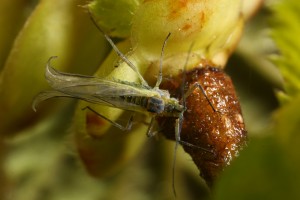
In this case, the aphid looked quite familiar to me – because of its size and coloration, it looked like the birch aphid (Euceraphis punctipennis). This is a very common species and although, as its name suggests, its host species is birch, there are often ‘rogue’ individuals that seem to fall, or get blown, on to other nearby trees. In this instance, there was a birch right next to the hazel where I found the aphid, so it seemed likely that was where it had come from.
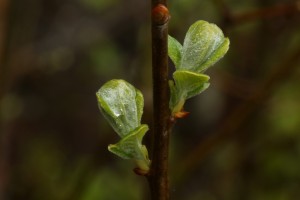
The aphids turned out to be a minor diversion this day though, as my eye kept getting drawn back to the new leaves of the trees. There was a special quality about them – a beautiful tenderness and pristine vulnerability that spoke of both the fragility and endurance of life at the same time. They have the same quality as new-born lambs, simultaneously embodying the joy of new life and the delicacy that is associated with that.
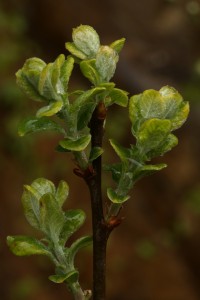
I now began deliberately looking for different species of trees in the area, to see and photograph their leaves as well, and almost at once I found an eared willow (Salix aurita) a few metres away.
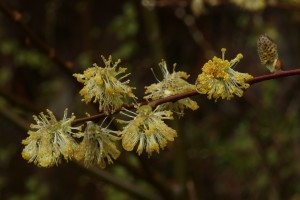
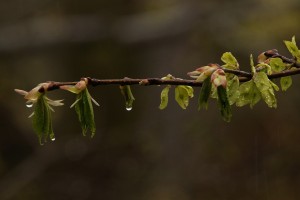
That eared willow was on the north side of the road, and when I turned to look south, over the Affric River below, in the gorge between Badger Falls and Dog Falls, my attention was drawn to distinctive shapes on the branches of a different tree – a wych elm (Ulmus glabra). This species is notable for having its seeds develop on its branches and twigs at the same time as its leaves emerge, and with this tree being lower down the slope from where I was standing, its branches provided an ideal eye-level view of its new leaves and seeds.
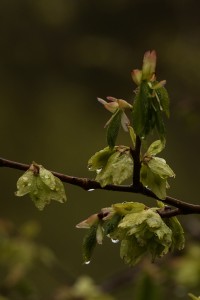
There are in fact two large wych elms growing side by side in this location, and apart from them, I only know of one other wych elm in the entire glen, which is about 12 miles to the west of this spot!
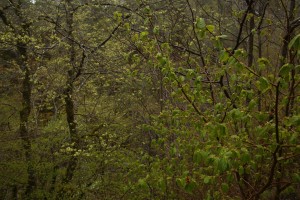
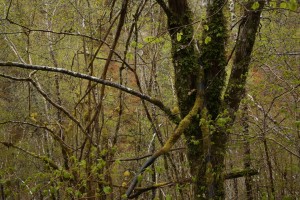
By this time I’d spent most of the day covering a distance of just 500 metres or thereabouts, such was my fascination with the trees and their new leaves in this part of the glen. Reaching Dog Falls itself, there was a mass of bright green new foliage on the dense stands of hazels in that area. The pale green of the leaves contrasted with the deeper green of the tree lungwort (Lobaria pulmonaria) that festooned the trunks of another goat willow.
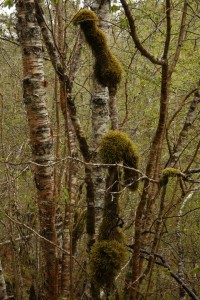
This is one of the lushest parts in the glen, being a small pocket of temperate rainforest. The constant humidity and spray in the air from the falls, together with the confined nature of the gorge, creates the perfect conditions for a profusion of mosses and lichens to flourish on the trees. It seemed like a good place to finish up for the day, and I took a few moments to reflect on the joy I’d experienced from the exuberant new flush of life bursting forth from all the trees. Somehow I felt as though there should be a special celebration for this time of the year. The return of the leaves is definitely a highlight in the annual cycle of the forest, providing both a dramatic contrast with the bare landscape of winter and the food source for the myriad insects that in turn support the birds that bring the forest alive with their songs at this time of year. In the absence of anything more formal though, I left the glen that day feeling as though the entire time had been my own personal celebration of the transformation of the trees into their green summer finery.
May I simply just say what a relief to discover someone that actually knows what they are talking about online. You actually know how to bring an issue to light and make it important. A lot more people ought to look at this and understand this side of the story. It’s surprising you aren’t more popular given that you definitely possess the gift.
Indeed, everything much later even, here on the Western Isles.
I wonder: What will be the consequences if a tree will produce only about ONE THIRD of the normal leaf volume?
I have a tree in my garden -planted by the person who lived here before – an Italian Alder (Alnus cordata). It has grown high (about 8 m at the moment) and was healthy and vigorous.
But this year the very strong gales and very cold weather into May/June have made it suffer. It was not able to “burst” leaves until very late (into Mid June) and many twigs are without.
Will it have enough strength to survive? What is your experience? I have seen quite a few similar affected trees this year.
As mine is very near the house I am wondering what will happen next winter? (Security questions). I love that tree outside my window and would hate to have to cut it down partially or even more drastic actions.
I would be grateful for a short answer. Loriana
Along with the change in the light, the return of the leaves is very special; definately worth celebrating! Thank you.
I only really came to love Spring and the special beauty of the different greens and the light passing through the leaves when they 1st emerge on the trees when I got my small farm that I manage in a traditional way for conservation here in Wales. All the plants are “spontaneous” and for reasons I don’t know the farmers never chose to improve it, so it can be seen and its fields known as they were of old, a very different aesthetic to modern fields. The old wet meadows have barely begun to grow at all in April and are still white/ochre when the 1st green leaves emerge on the trees. I find the ewes, those that are sick, love the new leaves of the hazel, hawthorn and willow- and sprigs of ivy.